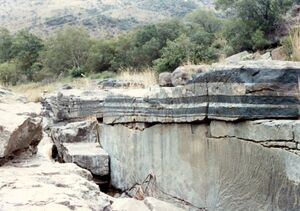v50 Steam/Premium information for editors
- v50 information can now be added to pages in the main namespace. v0.47 information can still be found in the DF2014 namespace. See here for more details on the new versioning policy.
- Use this page to report any issues related to the migration.
This notice may be cached—the current version can be found here.
Difference between revisions of "Igneous intrusive layer"
Jump to navigation
Jump to search
m (remove migrated tag, most of this is automated lookups) |
|||
| (9 intermediate revisions by 4 users not shown) | |||
| Line 1: | Line 1: | ||
| − | {{Quality| | + | {{Quality|Unrated}} |
{{av}} | {{av}} | ||
| − | '''Igneous intrusive | + | [[File:igneous_intrusive_layer.jpg|thumb|300px|right|Created from rocks that have crystallized from the heat of magma.]] |
| + | '''Igneous intrusive''' [[stone layers]] can consist of [[granite]], [[diorite]], or [[gabbro]], all of which typically contain [[gold]] and [[tetrahedrite]]. | ||
Gabbro can also contain [[garnierite]] (the ore of [[nickel]]), [[kimberlite]] (which may contain [[diamond]]s), and [[olivine]] (which may contain [[native platinum]]). Granite can contain [[cassiterite]] (the ore of [[tin]]), [[bismuthinite]] (the ore of [[bismuth]]), and [[galena]] (the ore of [[lead]], plus a 50% chance of silver). | Gabbro can also contain [[garnierite]] (the ore of [[nickel]]), [[kimberlite]] (which may contain [[diamond]]s), and [[olivine]] (which may contain [[native platinum]]). Granite can contain [[cassiterite]] (the ore of [[tin]]), [[bismuthinite]] (the ore of [[bismuth]]), and [[galena]] (the ore of [[lead]], plus a 50% chance of silver). | ||
| Line 23: | Line 24: | ||
==In the real world== | ==In the real world== | ||
| − | Igneous intrusive [[stone]] is formed by magma solidification occurring below the surface, as opposed to [[Igneous extrusive layer|igneous extrusive]] stone which forms above the surface of the earth. | + | Igneous intrusive [[stone]] is formed by magma solidification occurring below the surface, as opposed to [[Igneous extrusive layer|igneous extrusive]] stone, which forms above the surface of the earth. |
| − | |||
| − | |||
{{stones}} | {{stones}} | ||
{{Category|Stone Layers}} | {{Category|Stone Layers}} | ||
[[ru:Igneous intrusive layer]] | [[ru:Igneous intrusive layer]] | ||
Latest revision as of 12:13, 28 September 2023
v50.12 · v0.47.05 This article is about the current version of DF.Note that some content may still need to be updated. |
Igneous intrusive stone layers can consist of granite, diorite, or gabbro, all of which typically contain gold and tetrahedrite.
Gabbro can also contain garnierite (the ore of nickel), kimberlite (which may contain diamonds), and olivine (which may contain native platinum). Granite can contain cassiterite (the ore of tin), bismuthinite (the ore of bismuth), and galena (the ore of lead, plus a 50% chance of silver).
Igneous intrusive layers[edit]
Stone found in igneous intrusive layers[edit]
- Hematite (small clusters)
- Magnetite (small clusters)
- Orthoclase (large clusters)
Stone appearing in both igneous intrusive and igneous extrusive layers[edit]
- Native gold (veins)
- Cobaltite (veins)
- Pyrolusite (small clusters)
- Hornblende (small clusters)
Gems found in igneous intrusive layers[edit]
- Lapis lazuli (small clusters)
Gems appearing in both igneous intrusive and igneous extrusive layers[edit]
- Black zircon (small clusters)
- Green zircon (small clusters)
- Red zircon (small clusters)
- Brown zircon (small clusters)
- Yellow zircon (small clusters)
- Clear zircon (small clusters)
* See also: stone found everywhere
In the real world[edit]
Igneous intrusive stone is formed by magma solidification occurring below the surface, as opposed to igneous extrusive stone, which forms above the surface of the earth.
| Sedimentary | |||||
|---|---|---|---|---|---|
| Igneous |
| ||||
| Metamorphic | |||||
| Ore | |||||
| Economic | |||||
| Other |
Alunite · Anhydrite · Bauxite · Borax · Brimstone · Chromite · Cinnabar · Cobaltite · Cryolite · Graphite · Hornblende · Ilmenite · Jet · Kimberlite · Marcasite · Mica · Microcline · Olivine · Orpiment · Orthoclase · Periclase · Petrified wood · Pitchblende · Puddingstone · Pyrolusite · Realgar · Rutile · Saltpeter · Serpentine · Slade · Stibnite · Sylvite · Talc | ||||
